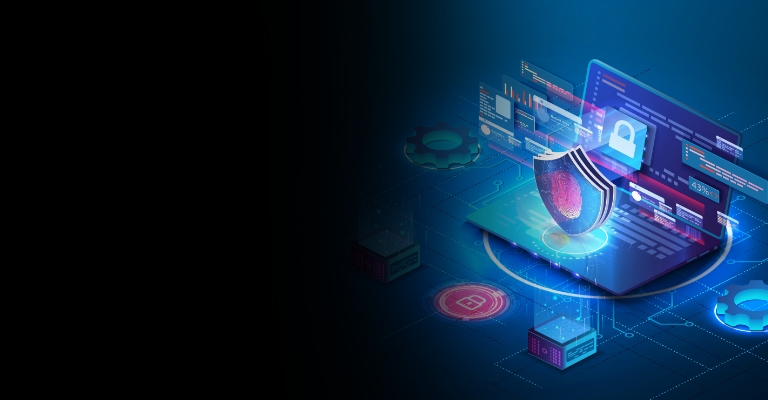We’re no longer limited to working from office mode, as remote and hybrid modes have made working more flexible and efficient. This trend also increased due to the rise of remote work since the Covid-19 pandemic in 2019-20. These unprotected entry points represent a significant risk for cyber threats. An endpoint refers to any device at the end of the network connectivity capable of receiving and transmitting information.
This category encompasses devices such as laptops, smartphones, and tablets and extends to Internet of Things (IoT) gadgets like smart televisions, printers, and surveillance cameras. Here, Endpoint protection and response (EDR) came into being to safeguard these endpoints.
Anton Chuvakin of Gartner introduced the concept of EDR, which he describes as a system that ""monitors and archives behaviors on the endpoint level of a system. He further said that EDR employs a range of data analysis techniques to identify unusual behavior on the system, offer details to understand the context, prevent harmful activities, and suggest measures for repairing systems
If you’re here to know more about EDR, Cybalt has brought this detailed blog.
What Is Endpoint Detection and Response (EDR)?
Safeguarding endpoints poses significant challenges. The variety of devices that constitute endpoints adds complexity to their security. The differences in operating systems, applications, software, and even the users' behavior and habits add further complexity.Moreover, bringing your own devices (BYOD) and the increase in remote working arrangements necessitate security personnel to secure a wide array of mobile endpoints. Consequently, EDR security measures must be more adaptable and robust to meet these evolving challenges.
It is a collective term for software programs that oversee the activities on your endpoints and notify the concerned team of any detected security incidents or unusual behavior. The range and functionality of EDR greatly differ. Some may be tailored with a specific purpose, while others are an element of a broader security monitoring framework.
Endpoint Detection and Response (EDR) systems are designed to continuously collect and evaluate data related to potential threats at endpoint levels. The core objective of these systems lies in detecting threats. EDR providers identify any security compromises through tools immediately as they arise and take the necessary steps in response.
Why is EDR Important?
The digital world is like a vast ocean, and every business, regardless of size, is trying to make its place. When there is technical support with EDR solutions, enterprises can fend off any unwanted threats lurking.
- A Proactive Approach for Cyberthreats
Gone are the days when you could wait for a cyberattack to enhance your cybersecurity measures. It's all about taking proactive steps in today's fast-paced digital world. This proactive approach to managing cyber threats is not just innovative; it's essential.
While useful back then, traditional antivirus software is now less useful. Hackers have evolved, building malware that can slip past these defenses. EDR service steps into this breach like a modern-day solution to cyber attacks. It can detect malware codes that are constantly evolving, ensuring they're caught and dealt with before they can do any damage. - Suitable for Medium to Large Scale Enterprises
Enterprises with vast networks are more susceptible to attacks because of their size. EDR is equipped with powerful tools to protect a network system. Its ability to continuously monitor and collect data across numerous endpoints makes it indispensable for large-scale networks. - Better Data Monitoring and Management
Data is the treasure every cyber attacker is behind. EDR monitors data safety. It collects, analyzes, and creates a map of all the risks for taking steps for avoidance. This level of scrutiny is unparalleled and forms the backbone of solid incident response strategies. It prepares you to fight off any cyberattacks with precision. - Generating Powerful Data Analytics
Imagine having a system that can predict threats before they even appear. The built-in data analytics in EDR solutions serve this very purpose. These tools have machine learning and statistical modeling for foresing and neutralizing threats.
- Observing Endpoints Without Interference in Productivity
EDR operates silently on endpoints. It keeps a watchful eye on the system for any disturbances. By being lightweight and non-intrusive, EDR continuously observes and monitors endpoints. It doesn't slow down operations, which means vigilance doesn't have to come at the cost of performance.
EDR systems also offer whitelisting and blacklisting options. That means you can flag known allies and adversaries. - Better and Real-Time Incident Response and Management
EDR solutions provide real-time data on threats, ensuring your business is always a step ahead. This quick access to information allows for immediate action, turning potentially dire situations into manageable situations with minimal damage.
- Compatibility and Integration with Other Security Tools
The companies need to use multiple tools, and managed EDR services know this well. They're designed to work harmoniously with other security tools to form a robust enterprise defense system. Whether it's integrating with malware analysis or threat intelligence tools, EDR systems have a comprehensive defense strategy.
Why Do Organizations Need Managed EDR Services?
- To Find Out Undetected Attacks
EDR adds more protection to cybersecurity infrastructure. It can analyze Indicators of Compromise (IOCs), such as suspicious IP addresses or URLs; EDR enables organizations to detect ongoing attacks promptly.
It provides analysts with a list of suspicious events to focus on key determining events that could indicate an attack.
- To Adopt Prevention-First approach
Equipped with advanced algorithms, machine learning, and AI-powered automated threat detection capabilities, EDR helps organizations adopt a prevention-first approach. This approach is more cost-effective than remediating after an attack.
EDR solutions prioritize proactive threat hunting to identify and block potential attacks before they can execute malicious code and compromise the system.
- To Enable a Flexible Working Environment,
Cybersecurity EDR facilitates organizations' embracing of modern workplace trends like Bring Your Device (BYOD) and hybrid working. EDR brings endpoint security through automated monitoring and response capabilities, reducing the burden on IT teams.
Teams can maintain strict security policies and safeguard endpoints round-the-clock for a secure modern workplace environment.
- To Know the Root Cause of Previous Cyber Attacks
Endpoint detection and response provide valuable insights into the attack chain by presenting ""threat cases. That treat case details all events before detection and illustrates the path of the attack.
This visual representation helps analysts understand the attack's origin and trajectory. So organizations can make more accurate attack responses and better prepare to prevent future attacks.
- Cloud-based unified management
Managed EDR simplifies endpoint device management and configuration through a cloud-based unified management system. Organizations can save time and resources by managing all endpoints.
- To Reduces false-positive percentages
EDR solutions investigate suspicious activities before alerting the security team and reduce the number of false-positive alerts.
Moreover, it also prioritizes alerts based on urgency and severity. EDR mitigates alert fatigue among security analysts, allowing them to focus on genuine threats effectively.
- To Quickly Respond to Incidents
Organizations also choose EDR to accelerate incident response time by automating processes. It isolates threats on demand and provides guided investigations with proposed remediation steps. EDR supports security teams in responding to threats quicker and more accurately, reducing the investigation time from four to five hours to a much shorter time frame.
How Does Managed EDR Work?
- Endpoint Monitoring and Data Collection
EDRs collect activity logs, processes, connections, and access information from various endpoints within the organization. The broader the scope of endpoints, the stronger the detection and response capabilities of the EDR. A robust EDR service provider aims to have comprehensive coverage across all endpoints.
- Response Capabilities
Effective EDRs operate in real time and provide timely alerts for potential breaches or compromises. They also come with intuitive dashboards summarizing information gathered from continuous monitoring efforts. Some EDR solutions may include automatic actions triggered by certain behaviors or detected agents.
These advanced EDR tools allow proactive response measures to neutralize threats without relying solely on post-alert actions.
- Forensic Investigation and Behavioral Analysis
Beyond detection and alerting, advanced EDR solutions offer forensic investigation and behavioral analysis. With the help of AI, machine learning, or other advancements, these features provide insights into how attackers compromised endpoints and infiltrated the organization's environment.
This comprehensive understanding helps organizations identify vulnerabilities and unknown exposures, enabling them to prioritize areas for strengthening security and preventing future attacks or compromises.
What Should You Look for in an EDR Solution?
- Threat Database
Effective EDR providers rely on extensive telemetry from endpoints to further enrich contextual information. A comprehensive threat database enables the solution to detect attack signs using various analytical techniques. - Behavioral Protection
Signature-based methods and indicators of compromise (IOCs) are insufficient for detecting evolving threats. EDR solutions should employ behavioral approaches to identify indicators of attack (IOAs) and alert organizations to suspicious activities before a compromise occurs.
Going for these EDR solutions prevents data breaches and enhances overall security posture. - Detailed Insight and Intelligence
Integration with threat intelligence sources enhances the contextual understanding of threats by providing details about the adversaries and attack tactics. EDR solutions with threat intelligence capabilities offer valuable insights that aid in proactive threat detection and response. - Go for a Cloud-based solutionCloud-based EDR solutions bring minimal impact on endpoints, real-time-search, analysis, and investigation capabilities, and scalability to accommodate evolving security needs. So, opting for a cloud-based EDR solution means seamless deployment and management with better security effectiveness. Please note only less than 40% of AI content can be used for the blog.
- Fast Response As per Risk,
Responding quickly and accurately to security incidents is crucial for preventing breaches and minimizing the impact on business operations. Managed services should facilitate swift incident response actions, enabling organizations to promptly stop attacks before they escalate into breaches and resume normal operations.
- Endpoint Visibility
A robust EDR solution should offer real-time visibility across all endpoints. That means organizations can monitor adversary activities and promptly respond to potential breaches within their environment.
Secure Your Endpoints with Cybalt's Advanced EDR Solutions
Don’t limit yourself to reactive security measures. Cybalt's EDR solutions leverage advanced algorithms and machine learning to detect and neutralize evolving malware threats before they can inflict harm.
Whether you're a small startup or a large corporation, our services are designed to scale with your business. To learn more, schedule a consultation with our cybersecurity experts.
Other Blogs

From Nuclear Centrifuges To Machine Shops: Securing IoT
IoT or ‘the internet of things’ has been around for a lot longer than the buzzword
Read More


Demystifying XDR
As the capabilities of threat actors have increased so have the tools which we utilize to detect and respond to their activities.
Read More


Cybersecurity In A Post Pandemic World
As many cyber security practitioners will tell you, the most imminent and dangerous threat to any network are the employees accessing it.
Read More


